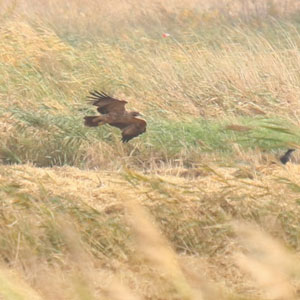Pratique | Identification
Identification d’un Aigle impérial immature en Camargue gardoise durant l’automne 2018

Aigle impérial (Aquila heliaca) de troisième année dans le secteur du Mas de Surville dans le département du Gard (France) en novembre 2018.
Photographie : Stephan Tillo
Introduction
L’Aigle impérial (Aquila heliaca) est un grand rapace nichant de l’Europe centrale au lac Baïkal en Sibérie orientale. Le plumage de l’adulte est brun-noir, avec la nuque jaune-crème et les épaules (scapulaires) blanches, tandis que le juvénile et les immatures sont beige plus ou moins marqués de sombre en fonction de l’âge, le plumage définitif n’étant acquis que vers cinq ans, après plusieurs mues.
L’Aigle ibérique (Aquila adalberti), qui ne niche qu’en Espagne et au Portugal, est une espèce très proche qui était autrefois considérée comme une sous-espèce. La distinction des immatures des deux espèces est très délicate, et une confusion est aisée : il n’a donc pas été simple d’identifier et de déterminer l’âge d’un Aigle impérial immature (très probablement de troisième année) découvert le 1er novembre 2018 dans le secteur du Mas de Surville (Gard), et encore présent le 6 décembre au moins.
Après une présentation de l’Aigle impérial et de la succession de ses plumages en fonction des mues, nous décrivons cette donnée remarquable et nous énumérons les critères ayant permis d’identifier l’Aigle impérial qui a séjourné dans le Gard. Nous remercions Loup Noally, Stephan Tillo, Thomas Krumenacker et Marc Fasol pour leurs photos.
Abstract
The Eastern Imperial Eagle (Aquila heliaca) is a large raptor breeding from central Europe to the Baikal lake in eastern Siberia. The adult plumage is black-brown, with a yellow-cream nape and white (scapular) shoulders, while juvenile and immature are creme-beige with more or less dark markings depending on the age, the definitive plumage being acquired only in five or six years, after several moults. The Spanish Imperial Eagle (Aquila adalberti), which only breeds in Spain and Portugal, is a very closely related species that was once considered a subspecies. The distinction between the immature of the two species is very delicate, and a confusion is easy: the identification and the determination of the age of a third-year Eastern Imperial Eagle, discovered the 1st of November 2018 in the sector of Mas de Surville (Gard), Southern France, and still present on the 6th of December 2018, were the subject of discussion among birders.
After a presentation of the species and the succession of the different immature plumages, we present the remarkable data of an immature bird in South France and we enumerate the criteria to distinguish it from a young Spanish Imperial Eagle and to age it. We thank Loup Noally, Stephan Tillo, Thomas Krumenacker and Marc Fasol for their photos.
Poursuivez la lecture de cet article, en vous abonnant dès maintenant !
Découvrez les Archives d’Ornithomedia.com
Pour seulement 10,00 €TTC/an (ou 6,00 € les 6 mois)
Profitez de plusieurs centaines d’articles en accès illimité et sans aucun engagement.
Compléments
À lire aussi sur Ornithomedia.com
- Étudier, observer et protéger l’Aigle impérial en Slovaquie
- L’Aigle impérial peut assez fréquemment se comporter comme un voleur
- La population d’Aigles ibériques semble avoir poursuivi sa progression en 2017
- Les périples de deux jeunes Aigles impériaux slovaques entre 2017 et 2018
- La Sierra Morena de Jaén, le domaine de l’Aigle ibérique et du Lynx pardelle
- Observer les oiseaux en Estrémadure : la Sierra de San Pedro
- L’impressionnante progression de l’Ibis falcinelle en Camargue gardoise depuis 2006
- Observer la Talève sultane et l’Ibis falcinelle en Camargue gardoise
- Identification en photos des Aigles criard et pomarin
- Observer les oiseaux dans le nord-ouest du Néguev (Israël)
- Hula Bird Festival 2012 : grues, aigles et compagnie
Dans la rubrique Observations d’Ornithomedia
Aigle impérial (Aquila heliaca)
Dans la galerie d’Ornithomedia.com
Aigle impérial (Aquila heliaca)
Sur le web
- Le site web collaboratif www.ornitho.fr
- Le site web de Thomas Krumenacker : www.krumenacker.de
Sources
- MaghrebOrnitho (2017). Spanish Imperial Eagle dispersion in North Africa in 2017. Maghrebornitho. Septembre. www.magornitho.org
- Daniel Lopez Vasco (2012). Spanish Imperial Eagle – Variation in juveniles and immatures. Birding Frontiers. Date : 05/09. https://birdingfrontiers.wordpress.com
- Stéphane Duchateau (2007). Statut de l’Aigle ibérique Aquila adalberti en France. Alauda. Numéro : 1. Pages : 33-42. www.gopa-pyrénées.fr
- William S. Clark (2004). Immature Plumages of the Eastern Imperial Eagle Aquila heliaca. Raptors Worlwide. www.raptors-international.org




Aucun commentaire sur ce sujet
Participer à la discussion !